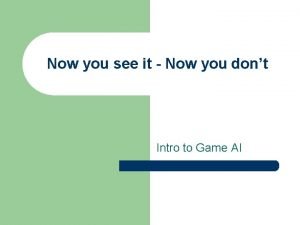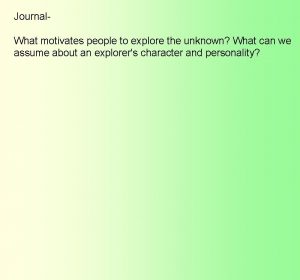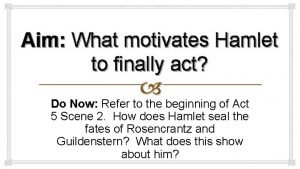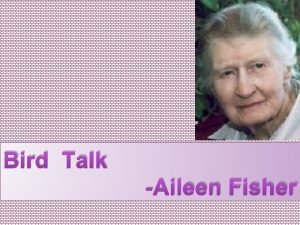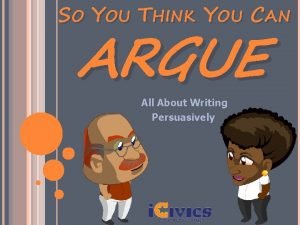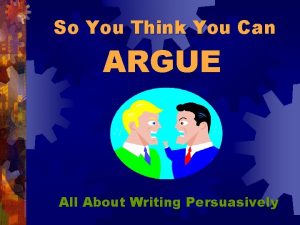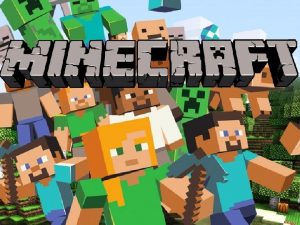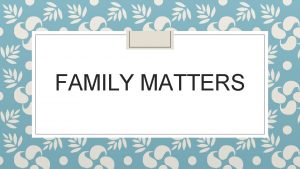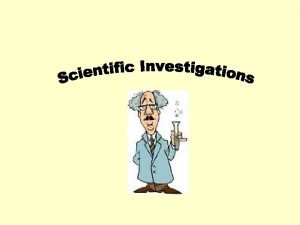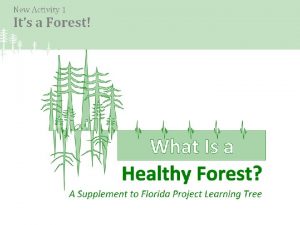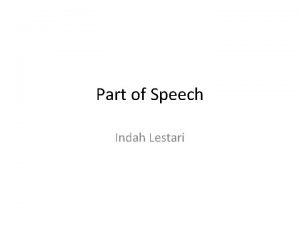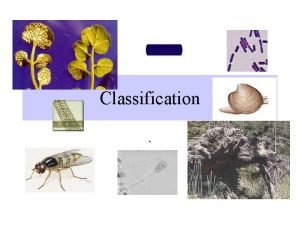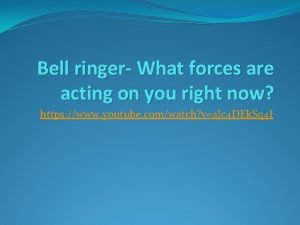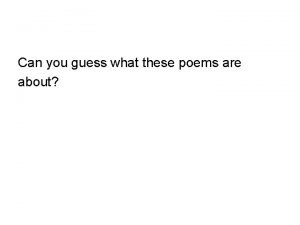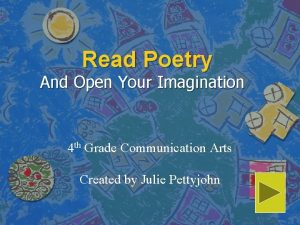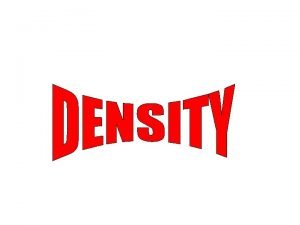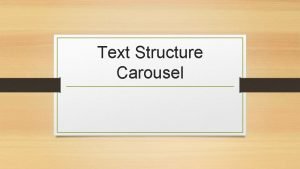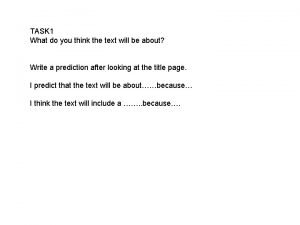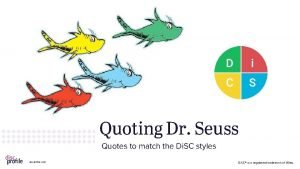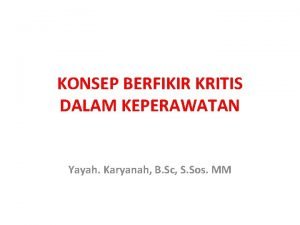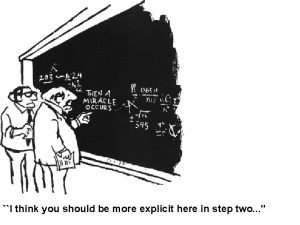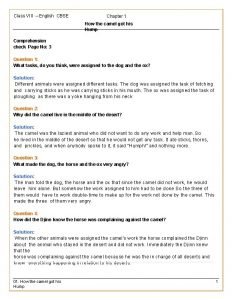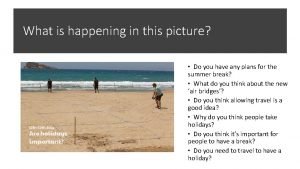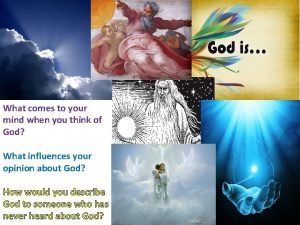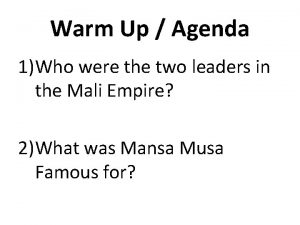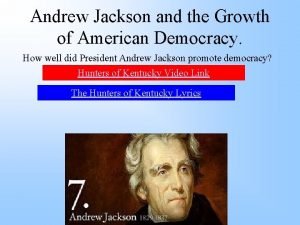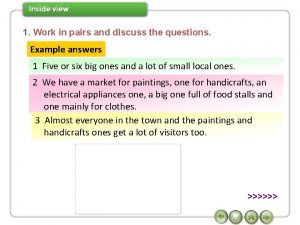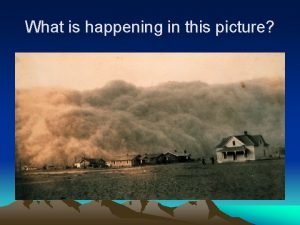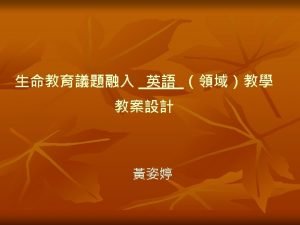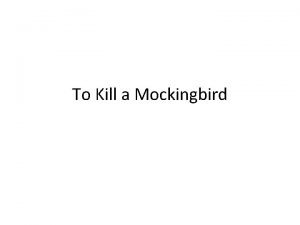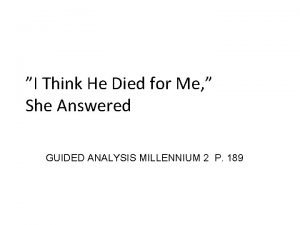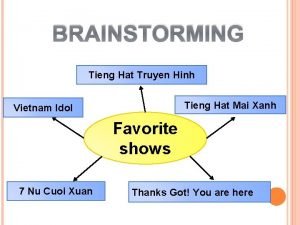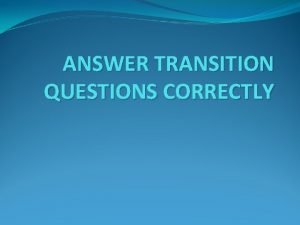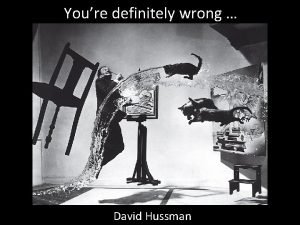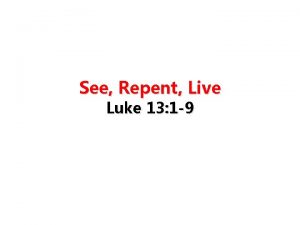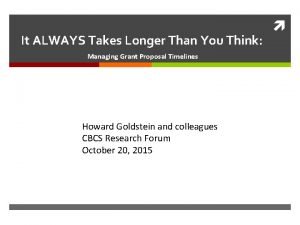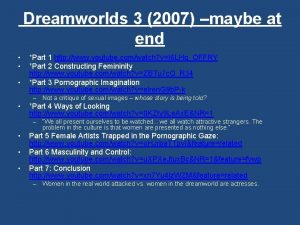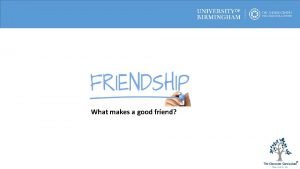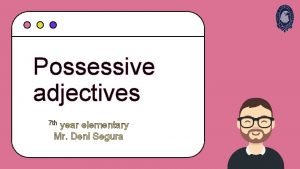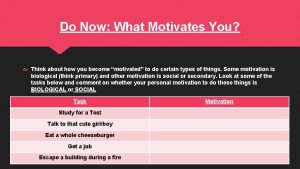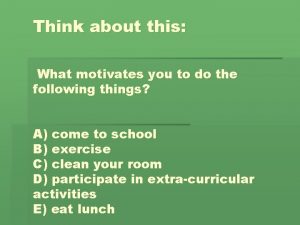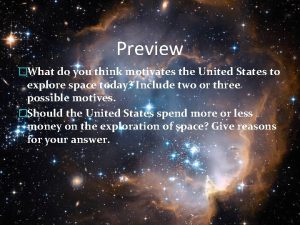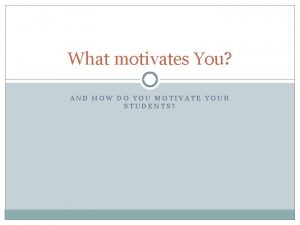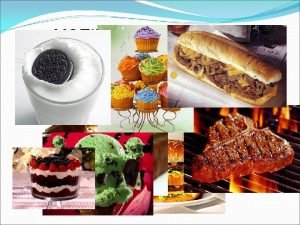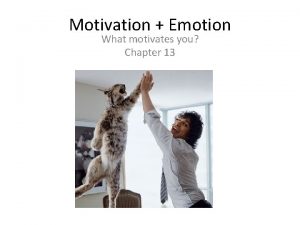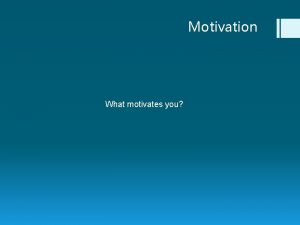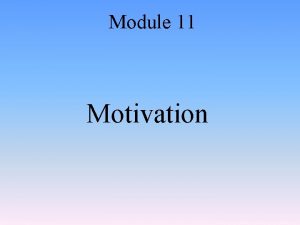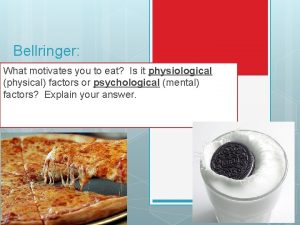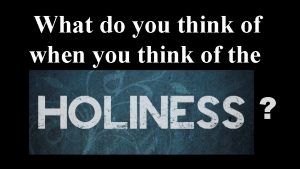Do Now What Motivates You Think about how

Do Now: What Motivates You? Think about how you become “motivated” to do certain types of things. Some motivation is biological (think primary) and other motivation is social or secondary. Look at some of the tasks below and comment on whether your personal motivation to do these things is BIOLOGICAL or SOCIAL Task Study for a Test Talk to that cute girl/boy Eat a whole cheeseburger Get a job Escape a building during a fire Motivation

AP Learning Objectives: Motivation and Emotion (6 -8%) 1. Identify and apply basic motivational concepts to understand the behavior of humans and other animals (i. e. instincts, incentives, intrinsic vs extrinsic motivation) 2. Discuss the biological underpinnings of motivation including needs, drives and homeostasis 3. Compare and contrast the motivational theories (i. e. drive reduction theory, arousal theory, general adaptation theory) including the strengths and weaknesses of each 4. Describe research findings in specific motivation systems (eating, sex, social) 5. Discuss thetheories of stress and the effects on psychological and social well-being 6. Compare and contrast major theories of emotion (James-Lange, Cannon-Bard, Schacter Two Factor Theory) 7. Describe how cultural influences shape emotional expression, including variations in body language 8. Identify key contributors in the psychology of motivation and emotion (i. e. William James, Alfred Kinsley, Abraham Maslow, Stanley Schacter, Hans, Selye)

Chapter 8: Motivation and Emotion Why study motivation and emotion?

Get Motivated Monday!!!!!! (Or Thursday, whatever works 1) Does this video MOTIVATE you? Why or why not? 2) What makes a speech motivating? What makes it nonmotivating? Explain your answer

Chapter 8. 1: Approaches to Understanding Motivation How do psychologists define motivation, and what are the key elements of the early instinct and drive-reduction approaches to motivation?

Motivation Basics Motivation is the process by which activities are started, directed and continued so that physical or psychological needs or wants are met Types of Motivation 1. Extrinsic Motivation: The type of motivation in which a person performs an action because it leads to an outcome that is separate from or external from the person. Example: A child get $10 for every “A” on his report card or paying an employee a bonus check fr increased performance 2. Intrinsic Motivation: Type of motivation in which a person performs an action because the act itself is rewarding or satisfying in some internal manner. Example: A person volunteers at an animal shelter because they enjoy being around animals

Instinct Approaches Instincts: the biologically determined and innate patters of behavior that exist in both people and animals Instinct Approach: Approach to motivation that assumes people are governed by instincts similar to those of animals. Animal instincts include behaviors such as: migrating, nest building, mating and territorial protection are all examples of animal instincts Human instincts include behaviors such as: flight (running away), pugnacity (aggression), acquisition (gathering possessions)

Needs and Drives Need: a requirement of some material (such as food or water) that is essential to an organism’s survival. When an organism has a need, it leads to physiological tension and physical arousal that motivates the organism to act in order to fulfill this need and reduce the tension This action is known as a drive.

Drive Reduction Approaches Drive-Reduction Theory: approach to motivation that assumes behavior arises from physiological needs that cause internal drives to push the organism to act in order to satisfy the need and reduce tension and arousal. Primary Drives: Those drives that involve needs of the body such as hunger, thirst and sex Acquired (Secondary) Drives: Those drives that are learned through experience or conditioning, such as the need for money or social approval Homeostasis: The tendency of the body to maintain a steady state. Functions like a “thermostat” for the body

Practice Intrinsic vs Extrinsic Motivation : Movie/TV Clips There are several movies/TV shows that highlight motivation through speeches. Motivational speeches are a great way to tap into someone’s intrinsic or extrinsic motivation Watch the following motivational speeches from movies and decide if the speech is meant to appeal to the intrinsic or extrinsic part of human motivation. Title of Clip Remember the Titans Rocky One Tree Hill The Pursuit of Happiness Mighty Ducks Motivation Theory Explanation

Your Turn: What’s the Motivation Activity Now that you’ve learned about and practiced with Motivation Theories, your job will be to use those theories to explain a variety of common human behaviors. Using the words/theories in the box, try and explain the behaviors. There are several ways to answer each question, just be sure to correctly apply and define each term that you use

Homework Finish “What’s the Motivation? ”Activity if not completed in class Read/Take Notes on Chapter 8. 2: Types of Needs ACE Vocab 8. 1 and 8. 2 Multiple Intelligences Lesson Plan Project: Due Monday (A) or Tuesday (B)

The Science of Motivation: Video Questions 1) What is the “Distraction Effect”? 2) Which parts of the brain are linked to self-motivation? 3) What is the strongest motivator for sustained behavioral changes? 4) Why isn’t optimism always the best strategy for getting motivated? 5) What is the “What the Hell Effect’?

Video Questions: The Psychology of Power 1)How does the video define power? 2) What are the 6 sources of power? Briefly explain each source. 3) What strategies can you use to gain more power in public life? 4) Explain the statement: “Policy is frozen power” 5) Which 3 sources of power do you think are the most valuable? Explain your answer. 6) What does “Power” have to do with “Psychology”? Why should psychologists try to better understand power? Explain your answer

Ted Talk Questions: The Psychology of Evil 1) What is the psychological definition of evil, according to Zimbardo? 2) What do the results and findings from Abu Gharib teach us about “power” and “evil”? 3) What is the difference between “Disposition” and “Situation” ? Why are these terms important when looking at motivation for power and evil? 4) Describe the Milgram experiment and tell us how this experiment helps us understand power. 5) Describe Zimbardo’s prison guard experiment and how this experiment helps us to understand power 6) What are the “Keys to heroism”? 7) How can we link “evil” and “power” to motivation? Why is it important to study these things not just historically, but also psychologically? What can we gain from this?

Chapter 8. 2: Types of Needs What are the characteristics of the three types of needs?

Different Strokes for Different Folks: Needs are a fundamental part of motivation, however not all needs are strictly physical/biological. Psychologist David C Mc. Clelland proposed a theory that highlights the importance of 3 psychological needs typically ignored by other theories: Achievement Affiliation Power

Need for Achievement (n. Ach) The Need for Achievement (n. Ach) explains a strong psychological desire to succeed in attaining goals, both realistic and challenging. People who are high in n. Ach look for careers and hobbies that will allow for others to evaluate them. Achievement motivation appears to be strongly related to both academic and occupational success and the quality and amount of what a person produces

Need for Affiliation (n. Aff) Need for Affiliation (n. Aff): The need for friendly social interactions and relationships with others. People high in this need seek to be liked and held in high regard by others. n. Aff people make good teammates

Need for Power (n. Pow) Need for Power (n. Pow): the need to have control or influence over others People high in this need want to have their ideas heard (regardless of whether or not their ideas will lead to success) Status and prestige (and $$$) are important to people with a high n. Pow

Carol Dweck: Personality and n. Ach According to psychologist Carol Dweck, n. Ach is closely linked to personality factors Dweck focuses on the role that “view of self” plays in developing a high n. Ach She also believes that those with high n. Ach are the most likely to develop Learned Helplessness

Video Questions: Growth Mindset 1) What is a Growth Mindset? Explain a time where you had or did not have a growth mindset? 2) Compare the two types of mindset’s based on Carol Dweck’s research focused on n. Ach Fixed Mindset Growth Mindset

Do Now: What’s the Motivation? Dominic is at the movies, watching the latest psycho-thriller. In the middle of the movie, theater holds an intermission. How might the following explain the behavior that Dominic displays during the intermission: Intrinsic Motivation Extrinsic Motivation Drive Reduction Approach Homeostasis

Do Now: 3 Types of Psychological Needs Below fill in the chart, describing which of the 3 types psychological needs you feel best describes the people listed below (n. Ach, n. Pow, n. Aff) and provide a short explanation as to why Person A Team Captain A President (of a country or company) A Social Worker A Movie Star A Metro Student Type of Need (n. Ach, n. Pow, n. Aff) Explanation

Ted Talks: The Psychology of Self. Motivation 1) What is “feeling empowered”? What are three questions you can use to find out if someone is feeling empowered? 2) What’s the difference between “education” and “training”? 3) How can teachers/managers inspire confidence and self-motivation? (Success seekers vs Failure Avoiders)? What are the 4 C words? 4) Describe independence vs interdependence? What’s the problem with our Independence culture? 5) How does the narrator illustrate the 4 “C Words” through his “Drum Story”? 6) How can teachers, administrators and even parents use this information on motivation to increase student learning? Have you ever encountered someone who uses these well? Explain.

Chapter 8. 3 Arousal Approaches What are the key elements of the arousal and incentive approaches to motivation?

Arousal Approaches The need for stimulation is another explanation for motivation Stimulus motive: A motive that appears to be unlearned but causes an increase in stimulation, such as curiousity Arousal theory: theory of motivation in which people are said to have an optimal (best or ideal) level of tension that they seek to maintain by increasing or decreasing stimulation. Tasks or performances that are too low or too high may suffer


Yerkes-Dodson Law Yerkes-Dodson Law: Law stating that performance is related to arousal; moderate levels of arousal lead to better performance than do levels of arousal that are too low or too high. The effect varies with the difficulty of the task: Easy tasks require a high-moderate level whereas more difficult tasks require a low-moderate level. Example: A wife who is underaroused may pick a fight with her spouse Example: A student who has test anxiety (high level of arousal) may seek out ways to reduce that anxiety in order to improve test performance.

Sensation Seekers So if people are supposed to be seeking arousal levels around the middle, why do some people love to do high arousal things like bunjee jumping? Sensation Seeker: someone who needs more arousal than the average person. Sensation seekers seem to need more complex and varied sensory experiences Not all sensation seekers seek risky or dangerous, things like travelling or high energy workouts/sports can be tied to sensation seekers.

Incentive Approaches Incentives: Things that attract or lure people into action Incentive Approaches: Theories of motivation in which behavior is explained as a response to the external stimulus and its rewarding properties. (Similar to Operant Conditioning, remember? ? ) Expectancy-Value theories: Incentive theories that assume the actions of humans cannot be predicted or fully understood without understanding the beliefs, values, and the importance that a person attaches to those beliefs and values at any given moment of time. Often used to explain behaviors where there is no physical need (i. e. eating an entire piece of pie even though you’re not at all hungry)

Activity: Motivation Survey (What motivates you? ? ) and Anchor Chart n. Aff Stars What’s a n. Aff? Motivate me…. Don’t Motivate me… 1) Take the motivation survey you have been provided and calculate what types of things motivate you…are you an n. Pow, a n. Aff, or a n. Ach. 2) Find another person (or 2 or 3) who have the same (or at least a similar) motivation style as you (High in n. Pow, Low in n. Ach etc…) Create an anchor chart to help inform people about your motivation style. Organize it similar to the example on your left. Your chart should take into consideration: Famous Examples of this Motivation Group: Choose a few real life (or fictional) characters who you think embody this “motivational group” Problems with this type of motivation (i. e. n. Aff’s aren’t very productive with independent work, n. Pow’s only like group projects when they’re in charge etc…. ) Best ways to motivate this group (i. e. n. Ach’s will do ANYTHING for extra credit point) Worst ways to motivate this group (i. e. n. Aff’s don’t really care about extra credit) A Clear title and at least 3 -4 visuals

Homework Read/Notes 8. 4: Maslow’s Hierarchy of Needs Vocab 8. 3 and 8. 4 Work on Motivation Playlist Project

Chapter 8. 4: Humanistic Approaches: Maslow’s Hierarchy of Needs How do Maslow’s humanistic approach and self determination theory explain motivation?

Abraham Maslow: The Humanist Abraham Maslow was one of the earliest humanistic psychologists to study motivation. Maslow rejected the more cynical views of Freud and Behaviorists and favored a more positive view of human behavior Maslow proposed that there were several levels of needs that a person must meet before achieving the highest levels of personality fulfillment. Self-Actualization: The point that is seldom reached at which people have sufficiently satisfied the lowest needs and achieved their full human potential


Getting to the Top: Maslow’s Pyramid All the lowest level needs must be fulfilled before you can move to the top steps. This process is not linear, people can move up and down the pyramid as they go through life Peak experiences: times is a person’s life during which self-actualization is temporarily achieved Maslow’s pyramid is highly controversial as it is based purely on observation and not empirical research. It also fails to address cultures outside the United States.

Self-Determination Theory (Ryan and Deci, 2000) Self-Determination Theory (STD): A theory of human relationships in which the social context of an action has an effect on the type of motivation existing for the action. This theory relies on 3 inborn and universal human needs: Autonomy: The need to be in control of one’s behavior and goals Competence: The need to be able to master the challenging tasks of one’s life Relatedness: The need to feel a sense of belonging, intimacy and security in relationships with others

Maslow in Real Life: Video Questions 1) What is the problem discussed in the News Story? 2) Describe the program discussed in the video and what it does to address the needs of students. 3) What is the impact that hunger has on students in the classroom? 4) How does this story illustrate the use of Maslow’s theory in real life? Explain?

Maslow in the Movies: UP! Illustrate in your notebook how the movie Lion King Demonstrates each level of Maslow’s pyramid
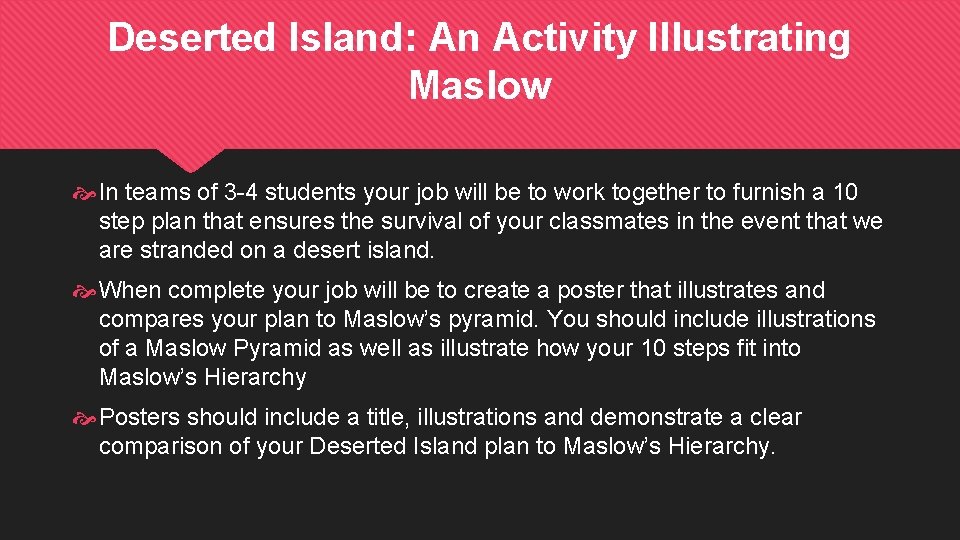
Deserted Island: An Activity Illustrating Maslow In teams of 3 -4 students your job will be to work together to furnish a 10 step plan that ensures the survival of your classmates in the event that we are stranded on a desert island. When complete your job will be to create a poster that illustrates and compares your plan to Maslow’s pyramid. You should include illustrations of a Maslow Pyramid as well as illustrate how your 10 steps fit into Maslow’s Hierarchy Posters should include a title, illustrations and demonstrate a clear comparison of your Deserted Island plan to Maslow’s Hierarchy.

Homework Article Review: “Below the Line”: Valdosta Daily Times (In Notebook) Vocab 8 -4 Zombie Game Pregame Preparation Worksheet
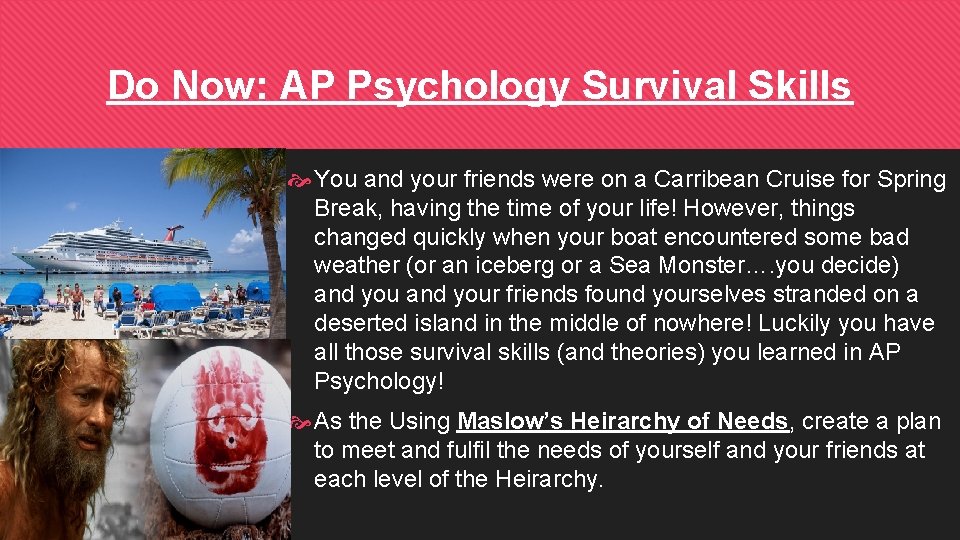
Do Now: AP Psychology Survival Skills You and your friends were on a Carribean Cruise for Spring Break, having the time of your life! However, things changed quickly when your boat encountered some bad weather (or an iceberg or a Sea Monster…. you decide) and your friends found yourselves stranded on a deserted island in the middle of nowhere! Luckily you have all those survival skills (and theories) you learned in AP Psychology! As the Using Maslow’s Heirarchy of Needs, create a plan to meet and fulfil the needs of yourself and your friends at each level of the Heirarchy.
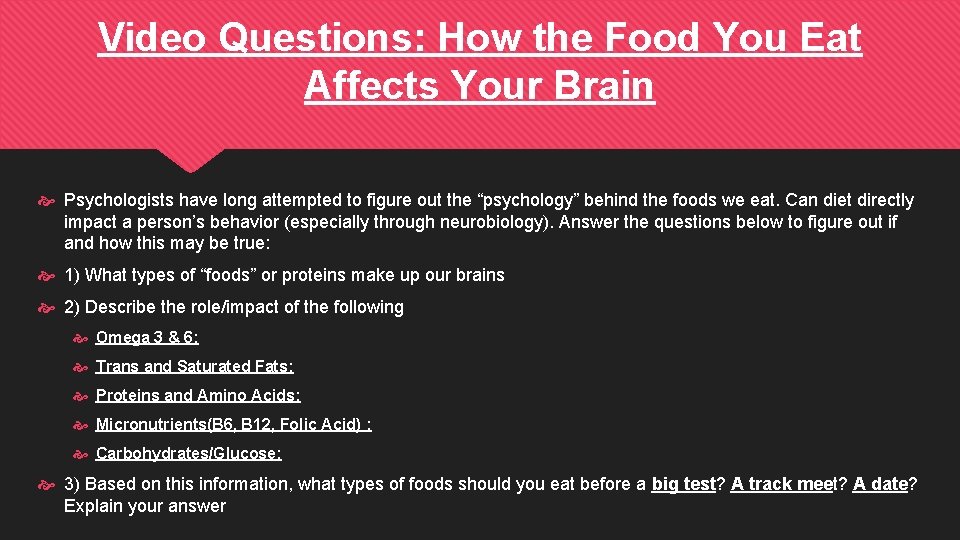
Video Questions: How the Food You Eat Affects Your Brain Psychologists have long attempted to figure out the “psychology” behind the foods we eat. Can diet directly impact a person’s behavior (especially through neurobiology). Answer the questions below to figure out if and how this may be true: 1) What types of “foods” or proteins make up our brains 2) Describe the role/impact of the following Omega 3 & 6: Trans and Saturated Fats: Proteins and Amino Acids: Micronutrients(B 6, B 12, Folic Acid) : Carbohydrates/Glucose: 3) Based on this information, what types of foods should you eat before a big test? A track meet? A date? Explain your answer

Chapter 8. 5: Hunger: Why do People Eat? What happens in the body to cause hunger, and how do social factors influence a person’s experience of hunger?

Why People Eat Hunger is one of the most basic needs of humans, however eating habits have recently come under extreme scrutiny. Eating is a primary behavior, but also serves as a form of pleasure and entertainment and helps satisfy social goals.

Physiological Components of Hunger Insulin: A hormone secreted by the pancreas to control the levels of fats, proteins and carbohydrates in the body by reducing the level f glucose in the bloodstream. Glucagons: Hormones that are secreted by the pancreas to control the levels of fats, proteins, and carbohydrates in the body by increasing the level of glucose in the bloodstream High blood sugar=more insulin=increased appetite.
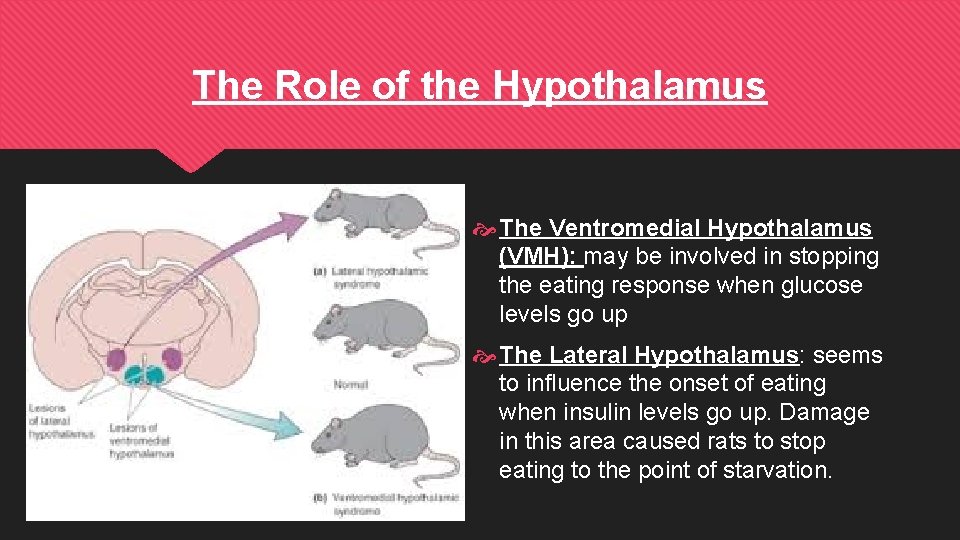
The Role of the Hypothalamus The Ventromedial Hypothalamus (VMH): may be involved in stopping the eating response when glucose levels go up The Lateral Hypothalamus: seems to influence the onset of eating when insulin levels go up. Damage in this area caused rats to stop eating to the point of starvation.

Weight Set Point and Basal Metabolic Rate Weight Set Point: The particular level of weight that the body tries to maintain. Metabolism- the speed at which the body burns available energy, is said to play a role in weight set point. Basal Metabolic Rate (BMR): The rate at which the body burns energy when the organism is resting Your BMR typically decreases with age
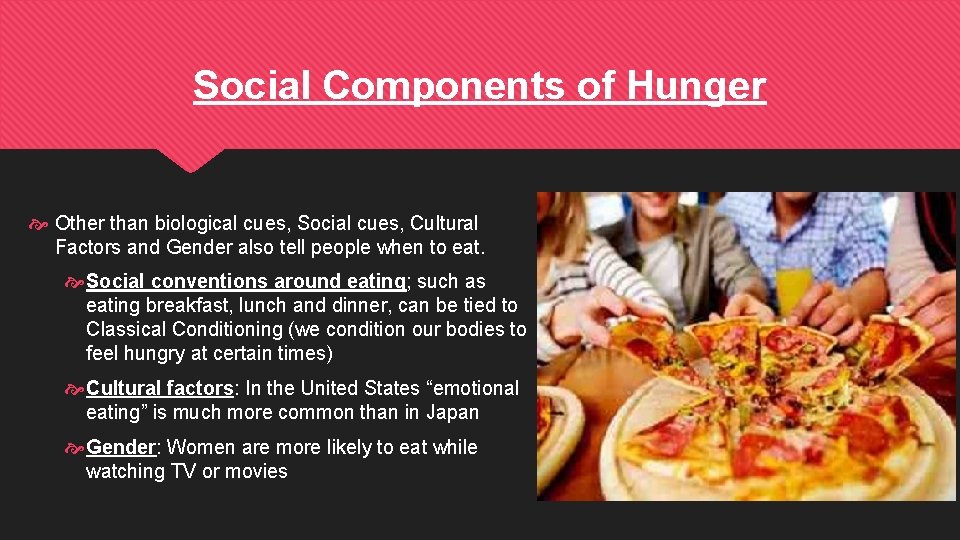
Social Components of Hunger Other than biological cues, Social cues, Cultural Factors and Gender also tell people when to eat. Social conventions around eating; such as eating breakfast, lunch and dinner, can be tied to Classical Conditioning (we condition our bodies to feel hungry at certain times) Cultural factors: In the United States “emotional eating” is much more common than in Japan Gender: Women are more likely to eat while watching TV or movies
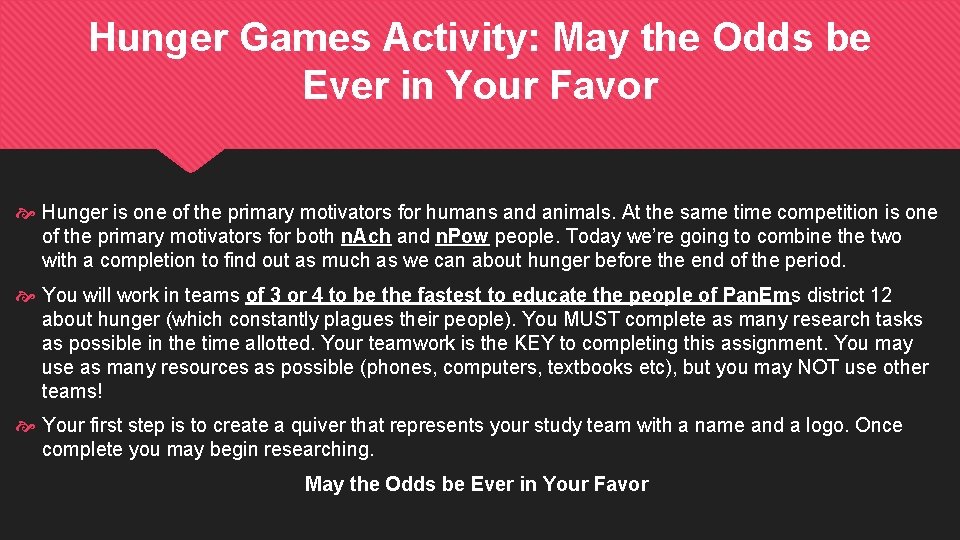
Hunger Games Activity: May the Odds be Ever in Your Favor Hunger is one of the primary motivators for humans and animals. At the same time competition is one of the primary motivators for both n. Ach and n. Pow people. Today we’re going to combine the two with a completion to find out as much as we can about hunger before the end of the period. You will work in teams of 3 or 4 to be the fastest to educate the people of Pan. Ems district 12 about hunger (which constantly plagues their people). You MUST complete as many research tasks as possible in the time allotted. Your teamwork is the KEY to completing this assignment. You may use as many resources as possible (phones, computers, textbooks etc), but you may NOT use other teams! Your first step is to create a quiver that represents your study team with a name and a logo. Once complete you may begin researching. May the Odds be Ever in Your Favor
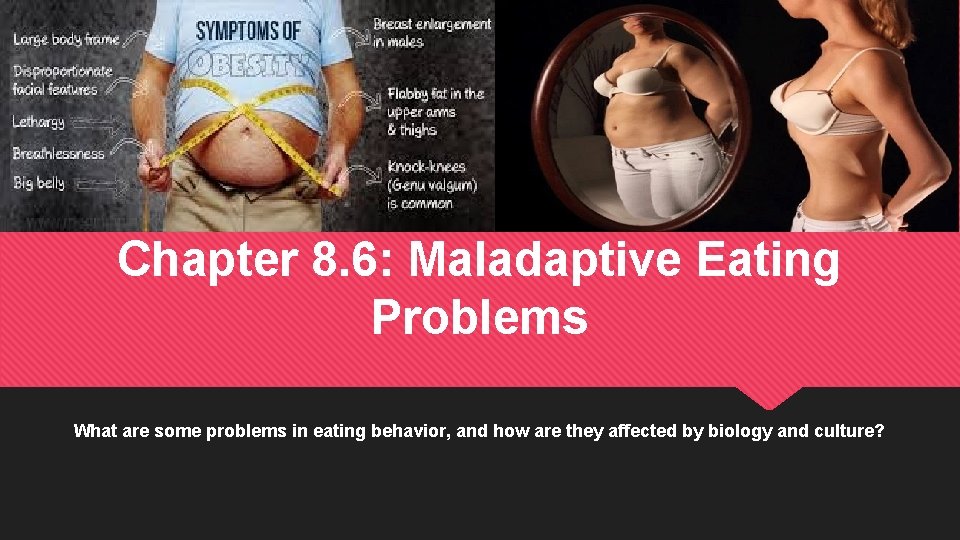
Chapter 8. 6: Maladaptive Eating Problems What are some problems in eating behavior, and how are they affected by biology and culture?
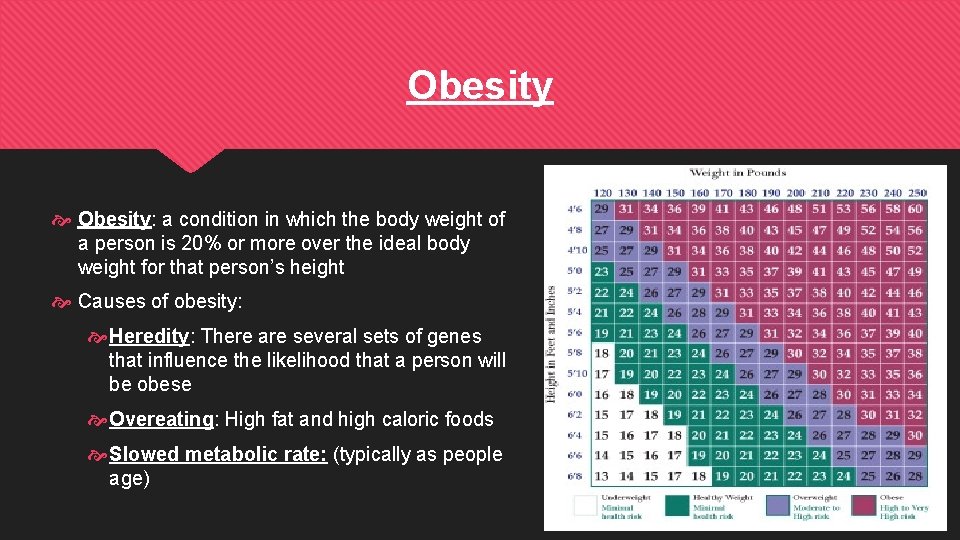
Obesity Obesity: a condition in which the body weight of a person is 20% or more over the ideal body weight for that person’s height Causes of obesity: Heredity: There are several sets of genes that influence the likelihood that a person will be obese Overeating: High fat and high caloric foods Slowed metabolic rate: (typically as people age)

Anorexia Nervosa Anorexia Nervosa: a condition in which a person (typically a young female) reducing eating to the point that a weight loss of 15% below expected body weight is the result. Causes of Anorexia: Biological: Genetic factors Psychological: Rejection of sexual maturity, sexual abuse, perfectionism, and/or control issues Treatment Options Hospitalization/In patient treatment: Outpatient treatment: Therapy, Group counseling

Bulimia Nervosa Bulimia Nervosa: A condition in which a person develops a cycle of “Binging” or overeating enormous amounts of food at one sitting and then using unhealthy methods to avoid weight gain. Causes of Bulimia: Biological: Genetic, serotonin imbalance Psychological: Issues with control, anxiety Treatment Options: In patient/ Hospitalization Serotonin regulatory drugs Cognitive therapy

Do Now: 1. 4. 2. 5. 3. 6. In your notebook, try and identify the feelings/emotions of the 6 people on the left. (Think ‘Inside Out’ for some inspiration • • • Check Yourself 1)Happyness/Joy 2) Sadness 3) Disgust 4) Anger 5) Surprise 6) Fear
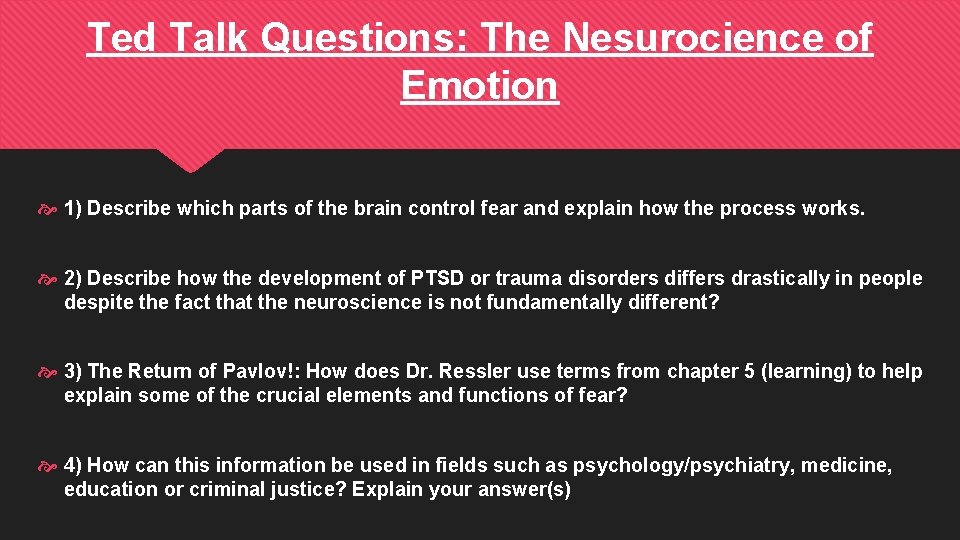
Ted Talk Questions: The Nesurocience of Emotion 1) Describe which parts of the brain control fear and explain how the process works. 2) Describe how the development of PTSD or trauma disorders differs drastically in people despite the fact that the neuroscience is not fundamentally different? 3) The Return of Pavlov!: How does Dr. Ressler use terms from chapter 5 (learning) to help explain some of the crucial elements and functions of fear? 4) How can this information be used in fields such as psychology/psychiatry, medicine, education or criminal justice? Explain your answer(s)
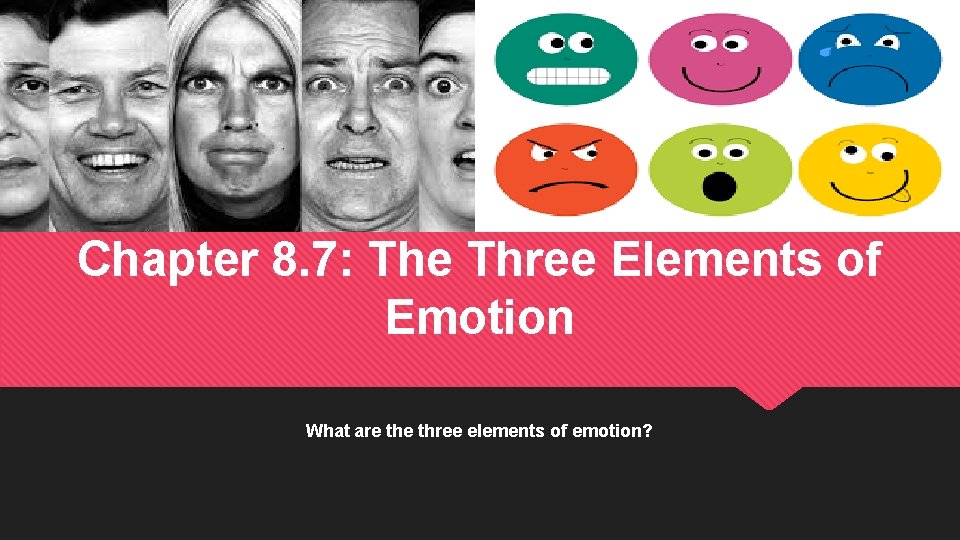
Chapter 8. 7: The Three Elements of Emotion What are three elements of emotion?

Emotion Emotion: The “feeling” aspect of consciousness, characterized by a certain physical arousal, a certain behavior that reveals the emotion to the outside world, and an inner awareness of feelings.
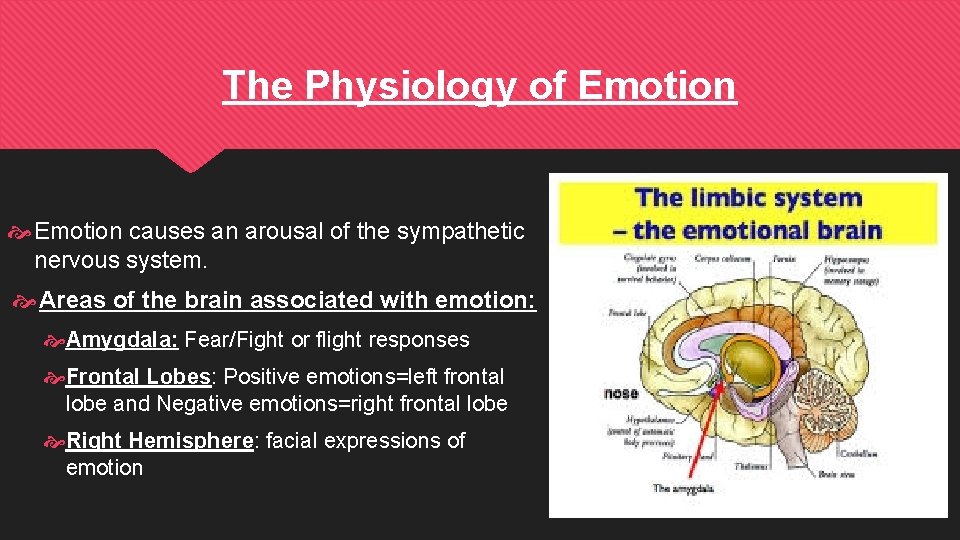
The Physiology of Emotion causes an arousal of the sympathetic nervous system. Areas of the brain associated with emotion: Amygdala: Fear/Fight or flight responses Frontal Lobes: Positive emotions=left frontal lobe and Negative emotions=right frontal lobe Right Hemisphere: facial expressions of emotion
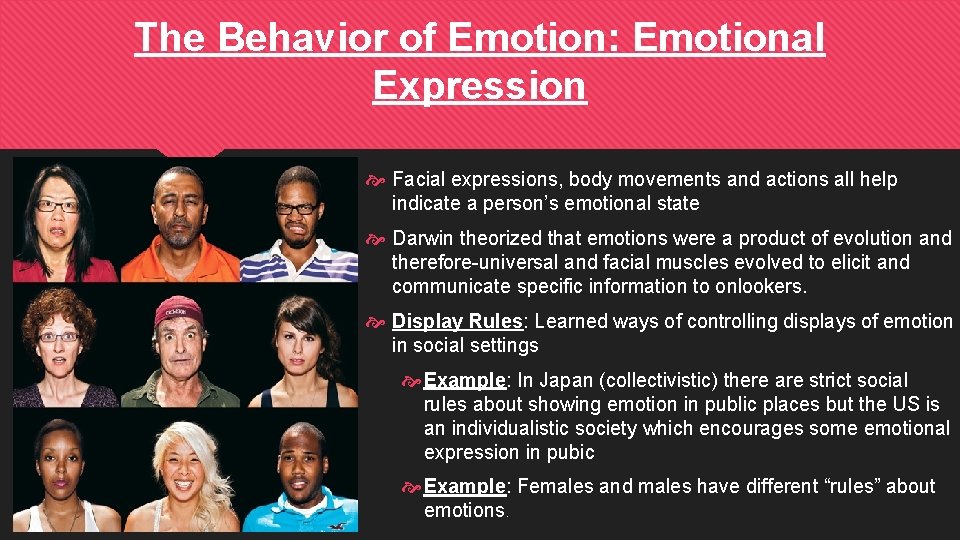
The Behavior of Emotion: Emotional Expression Facial expressions, body movements and actions all help indicate a person’s emotional state Darwin theorized that emotions were a product of evolution and therefore-universal and facial muscles evolved to elicit and communicate specific information to onlookers. Display Rules: Learned ways of controlling displays of emotion in social settings Example: In Japan (collectivistic) there are strict social rules about showing emotion in public places but the US is an individualistic society which encourages some emotional expression in pubic Example: Females and males have different “rules” about emotions.

Subjective Experience: Labeling Emotion Interpreting and labelling emotions is also known as the “cognitive element” as memories help us to label emotions The label a person applies to a subjective feeling is partly a learned response influenced by language and cultures Example: Chinese Americans are more likely to use labels to describe their emotions that refer to bodily sensations (i. e. “dizzy) or relationships (i. e. friendship). While Americans tend to use more directly emotional words (“liking” or “love”)

Paul Ekman: The Seven Basic Emotions Paul Ekman, a leading psychologist in emotions, suggests humans everywhere can recognize seven basic emotions: sadness, fear, anger, disgust, contempt, happiness and surprise. • Anger • Happiness • Disgust • Surprise • Sadness • Fear Display Rules: According to Ekman, the seven emotions are universal, but the display rules vary greatly, depending on the culture. He defines display rules as the permissible ways of displaying emotions in a given society.
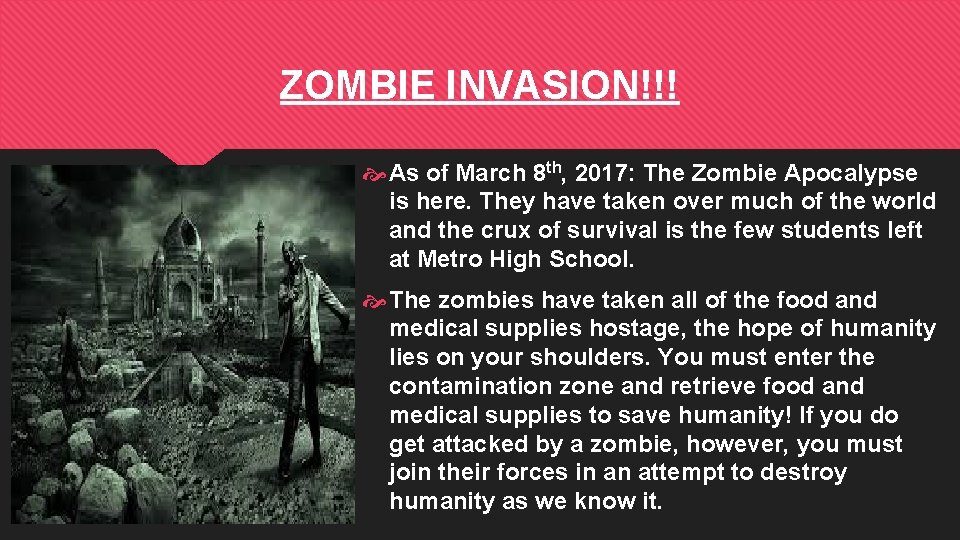
ZOMBIE INVASION!!! As of March 8 th, 2017: The Zombie Apocalypse is here. They have taken over much of the world and the crux of survival is the few students left at Metro High School. The zombies have taken all of the food and medical supplies hostage, the hope of humanity lies on your shoulders. You must enter the contamination zone and retrieve food and medical supplies to save humanity! If you do get attacked by a zombie, however, you must join their forces in an attempt to destroy humanity as we know it.

Homework Read and take notes: 8 -10 Zombie Game handout: Pgs 1 and 3 (We will do 2 after notes next class))
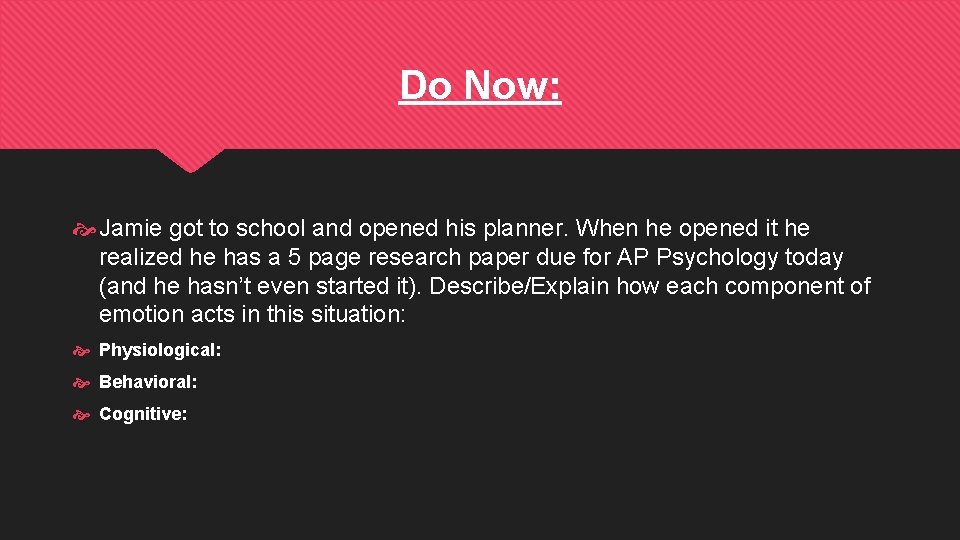
Do Now: Jamie got to school and opened his planner. When he opened it he realized he has a 5 page research paper due for AP Psychology today (and he hasn’t even started it). Describe/Explain how each component of emotion acts in this situation: Physiological: Behavioral: Cognitive:

Fun Friday Video Clip: Soul Pancake: Kids Explain Why We Feel Emotional Watch the following video clip where little kids explain why we feel emotional. After the video reflect on the following: 1) Which was your favorite explanation for emotion? Why 2) Were any of these explanations close to the real, psychological explainations of why we have emotions? If so, which one(s) and why?

Crash Course Psychology Emotions: Video Questions 1) What are the 3 components that make up an emotion: 2) Describe/Draw the James-Lange Theory of Emotion and provide an example 3) Describe/Draw the Cannon-Bard Theory of Emotion and provide an example 4) Describe/Draw the Schlater-Singer Theory of Emotion and provide an example 5) Explain the Spillover Effect 6) Which of these Theories of emotion do you most agree with? Explain your answer.
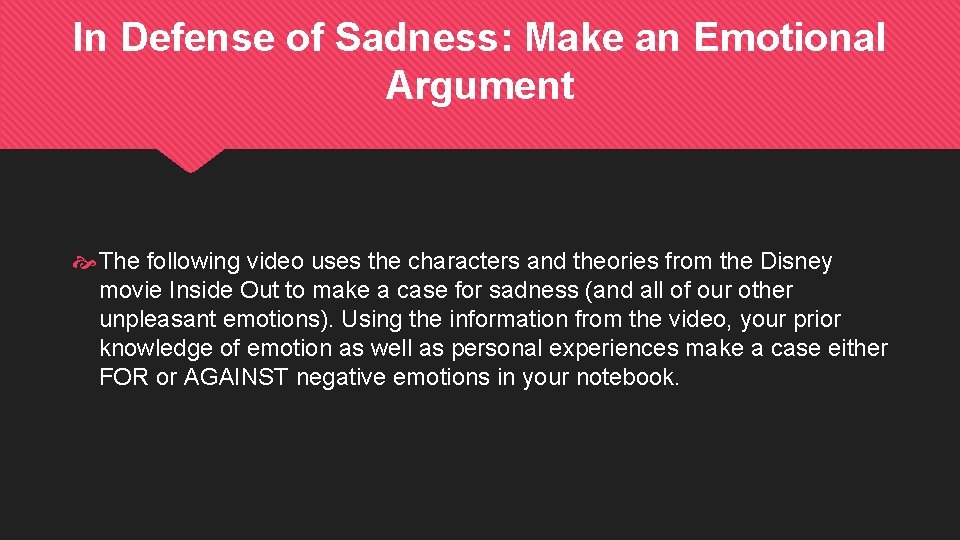
In Defense of Sadness: Make an Emotional Argument The following video uses the characters and theories from the Disney movie Inside Out to make a case for sadness (and all of our other unpleasant emotions). Using the information from the video, your prior knowledge of emotion as well as personal experiences make a case either FOR or AGAINST negative emotions in your notebook.
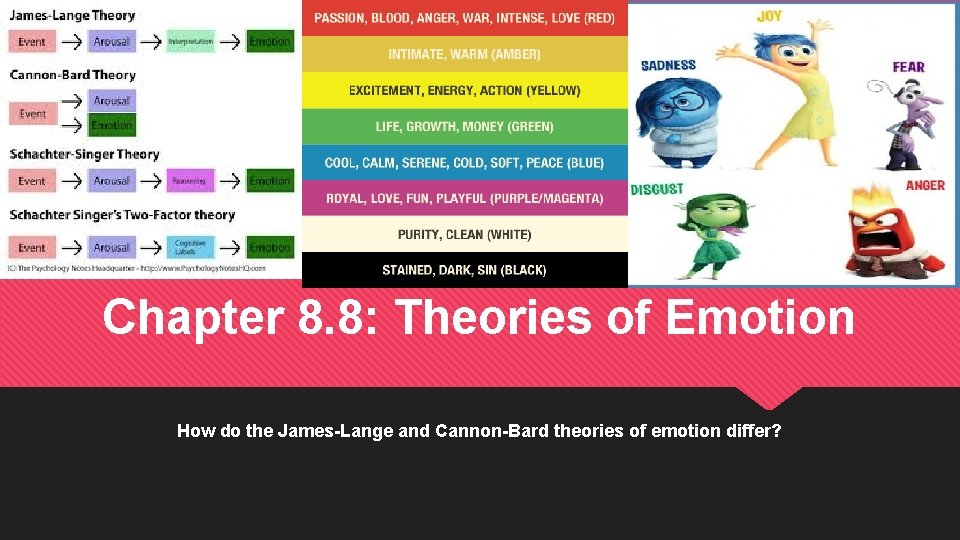
Chapter 8. 8: Theories of Emotion How do the James-Lange and Cannon-Bard theories of emotion differ?

The James-Lange Theory of Emotion James Lange Theory: An emotion-arousing stimulus in the environment triggers a physiological reaction and behavior. Our awareness of the physiological reaction leads to our experience of an emotion. James believed that emotion followed this sequence: 1. We perceive a stimulus. 2. Physiological and behavioral changes occur. 3. We experience a particular emotion.
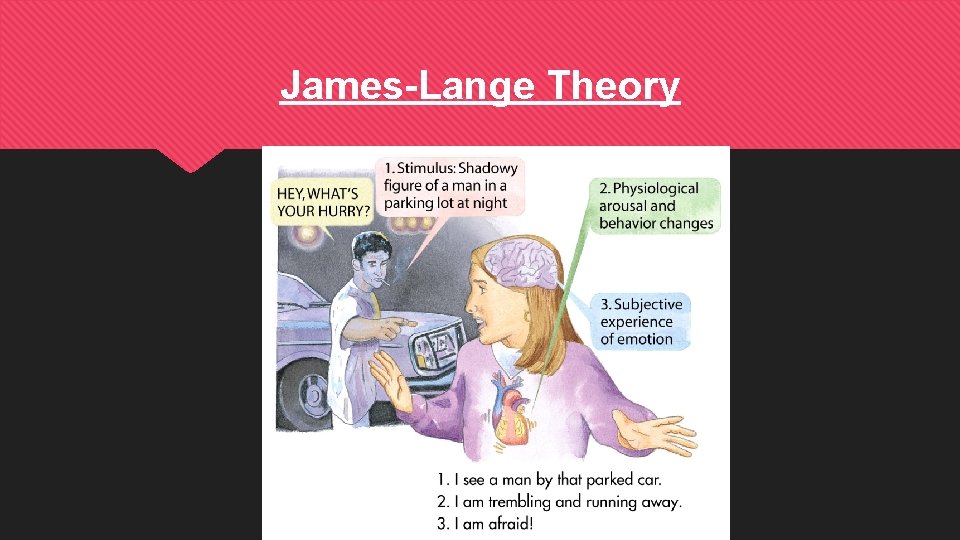
James-Lange Theory




2. Cannon-Bard Theory: An emotion-arousing stimulus simultaneously triggers both a physiological response (sympathetic nervous system) and the experience of an emotion (brain’s cerebral cortex).
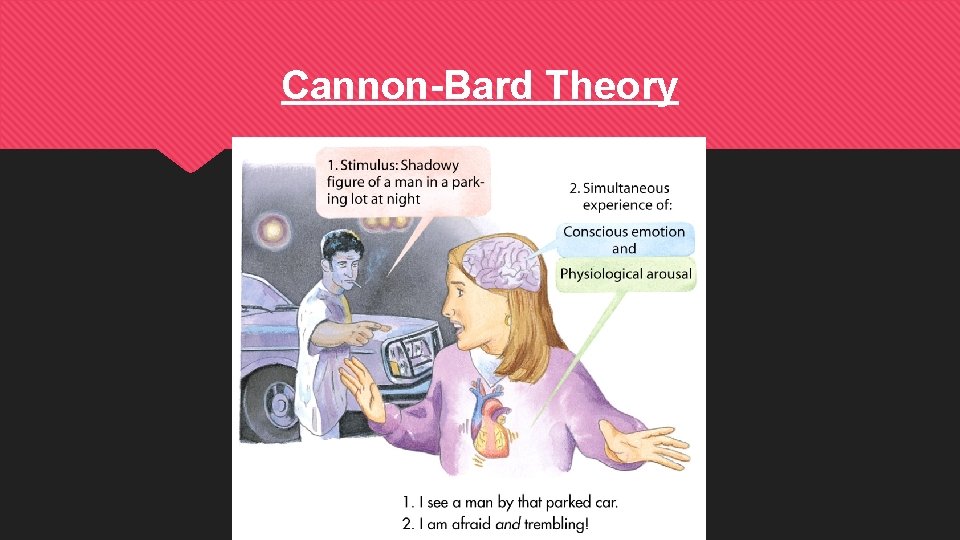
Cannon-Bard Theory


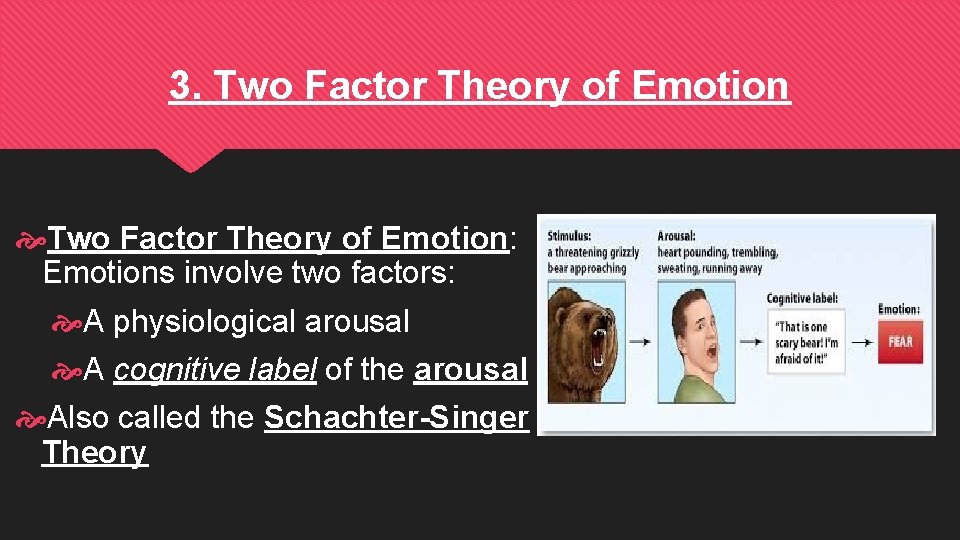
3. Two Factor Theory of Emotion: Emotions involve two factors: A physiological arousal A cognitive label of the arousal Also called the Schachter-Singer Theory
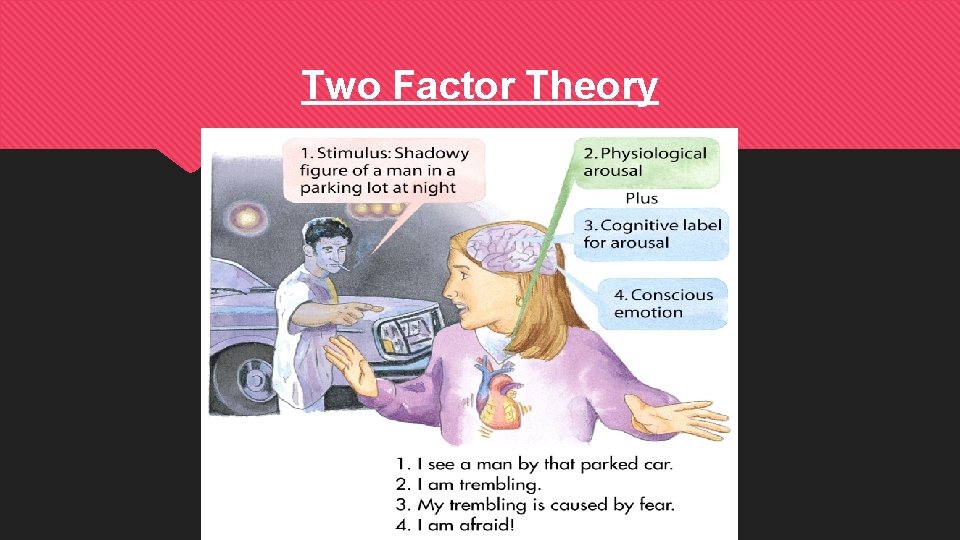
Two Factor Theory
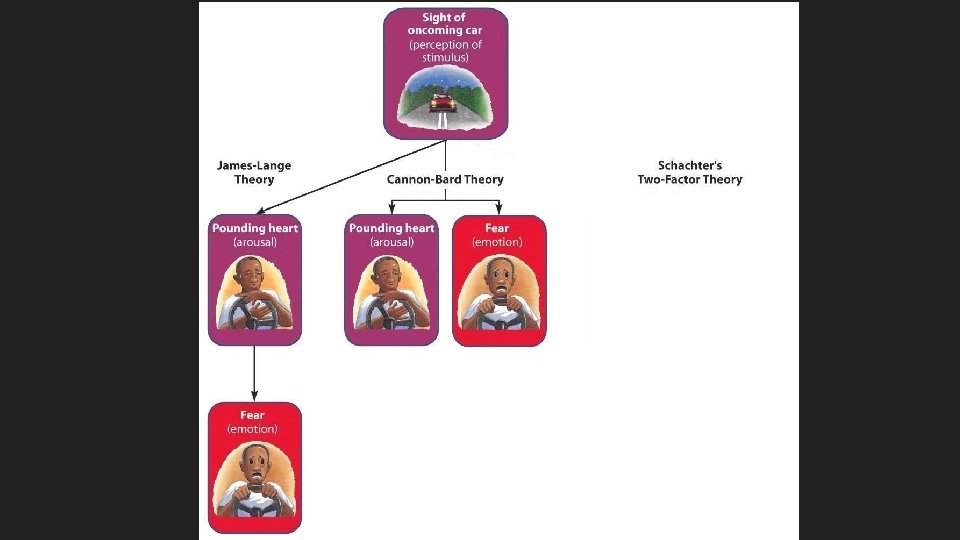

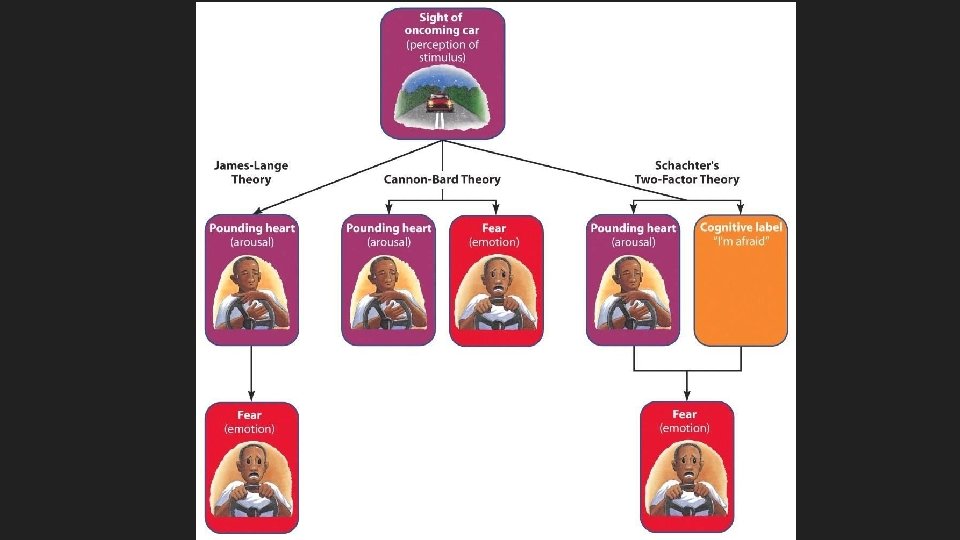

James. Lange theory Cannonbard theory Twofactor theory Stimulus: snake Physiological arousal trembling increased heart rate Emotion fear Physiological arousal trembling increased heart rate Stimulus Cognitive interpretation “I feel afraid!” Emotion fear

Chapter 8. 9: Cognitive Theories of Emotion What are the key elements of the cognitive arousal theory, the facial feedback hypothesis and the cognitive mediational theory of emotion?

The Facial Feedback Hypothesis: Theory of emotion that assumes that facial expressions provide feedback to the brain concerning the emotion being expressed , which in turn causes and intensifies the emotion
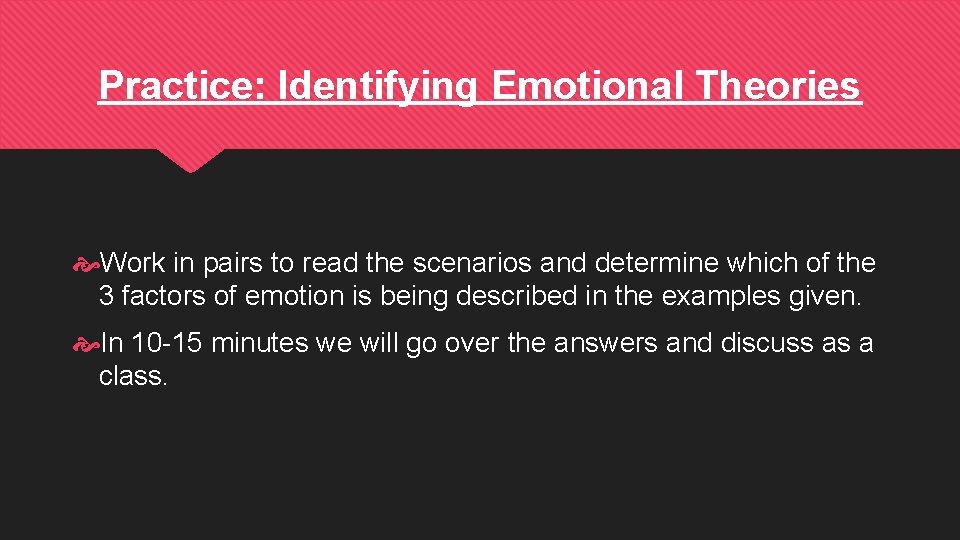
Practice: Identifying Emotional Theories Work in pairs to read the scenarios and determine which of the 3 factors of emotion is being described in the examples given. In 10 -15 minutes we will go over the answers and discuss as a class.
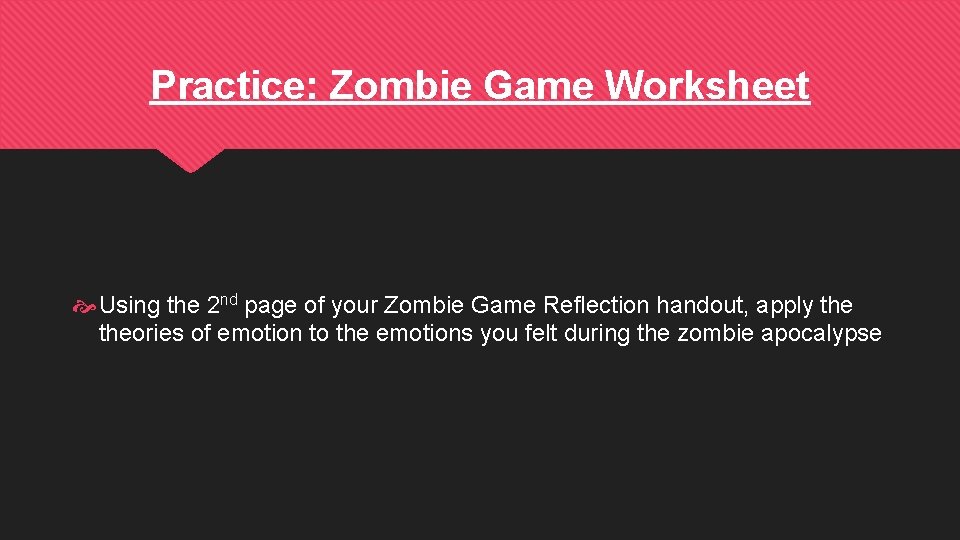
Practice: Zombie Game Worksheet Using the 2 nd page of your Zombie Game Reflection handout, apply theories of emotion to the emotions you felt during the zombie apocalypse
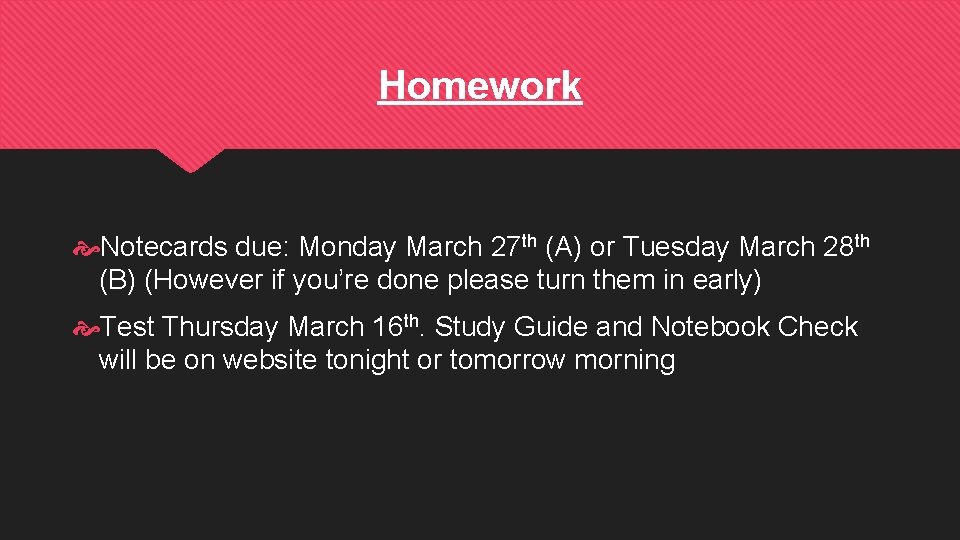
Homework Notecards due: Monday March 27 th (A) or Tuesday March 28 th (B) (However if you’re done please turn them in early) Test Thursday March 16 th. Study Guide and Notebook Check will be on website tonight or tomorrow morning
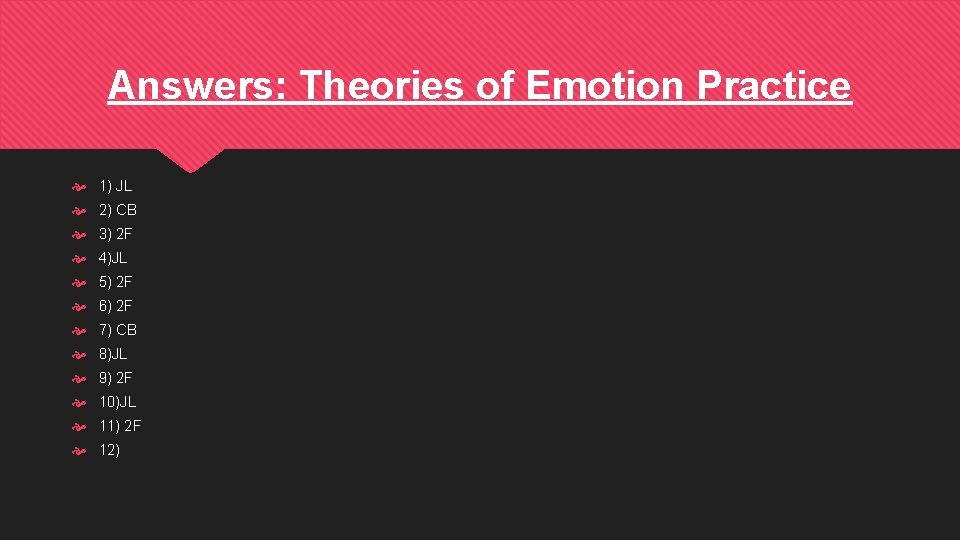
Answers: Theories of Emotion Practice 1) JL 2) CB 3) 2 F 4)JL 5) 2 F 6) 2 F 7) CB 8)JL 9) 2 F 10)JL 11) 2 F 12)
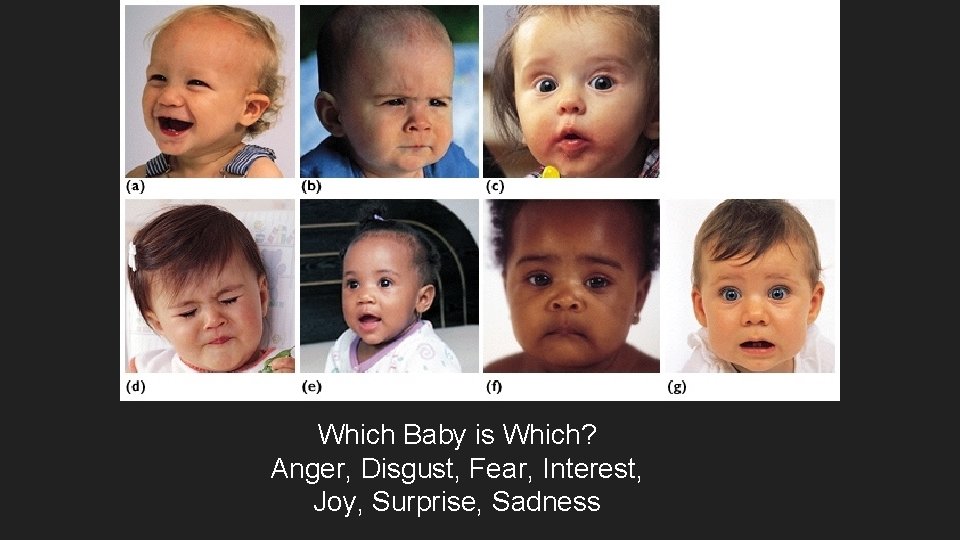
Which Baby is Which? Anger, Disgust, Fear, Interest, Joy, Surprise, Sadness
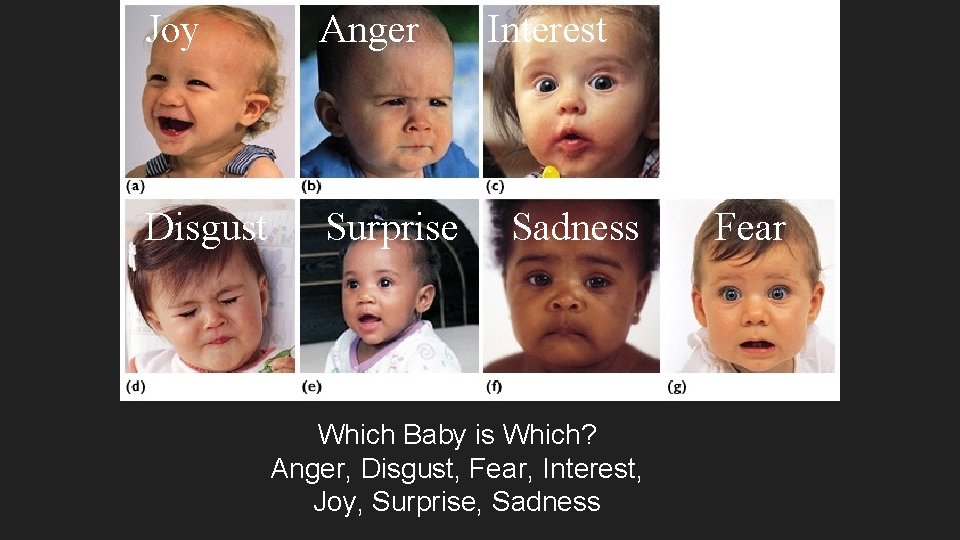
Joy Anger Disgust Surprise Interest Sadness Which Baby is Which? Anger, Disgust, Fear, Interest, Joy, Surprise, Sadness Fear
- Slides: 93

